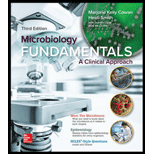
Archaea
- a. are most genetically related to bacteria.
- b. contain a nucleus.
- c. cannot cause disease in humans.
- d. lack peptidoglycan in their cell walls.
Introduction:
The domain classification consists of prokaryotes, eukaryotes, and archaea. The prokaryotes include the group of bacteria which are unicellular organisms, without a nucleus and chromosomes condensed in the cytoplasm. Archaea include the group of ancient bacteria. The domain eukaryotes include protists, fungi, Plantae, and animalia.
Answer to Problem 1Q
Correct answer:
Archaea lack peptidoglycan in their cell walls. Therefore, option (d) is correct.
Option (d) is given as “lack peptidoglycan in their cell walls”.
Explanation of Solution
Justify the reasons for the correct statement:
Archaea contains single and circular chromosomes. Ribosomes are the 70S, but their structure is similar to 80S. Nucleus and membrane-bound organelles are absent but have a bacterial-like metabolism. The peptidoglycans and cell wall are absent in archaea, but theseare present in bacteria.
Hence, option (d) is correct.
Justify the reasons for the incorrect statements:
Option (a) is given as “are most genetically related to bacteria”.
Archaea are genetically related to bacteria. Archaea initially are defined as archaebacteria. Hence, it is a wrong answer.
Option (b) is given as “contain a nucleus”.
Both archaea and bacteria are unicellular organisms and contain do not contain a nucleus. Hence, it is a wrong answer.
Option (c) is given as “cannot cause disease in humans”.
Both bacteria and archaea can be opportunistic pathogens and cause disease in humans. Hence, it is a wrong answer.
Hence, options (a),(b), and(c) are incorrect.
It was once thought that bacteria and archaea belonged to the prokaryotic domain and similar to bacteria, but later they showed some distinctive difference in their cell wall and ribosomes.
Want to see more full solutions like this?
Chapter 3 Solutions
Microbiology Fundamentals: A Clinical Approach
- Which of the following statements is not true?(A) Archaea and bacteria have different membrane lipids.(B) The cell walls of archaea lack peptidoglycan.(C) Only bacteria have histones associated with DNA.(D) Only some archaea use CO2 to oxidize H2, releasing methanearrow_forwardArchaea differ from bacteria in that theya. have a nucleus.b. have membrane-bound organelles.c. have peptidoglycan in their cell walls.d. are often photosynthetic.e. None of these are correct.arrow_forwardWhich is false regarding Archaea?(a) They lack a nucleus.(b) They are considered to be one of the three domains oflife.(c) The often live in extremely hot or salty environments.(d) They lack cell walls.(e) They are responsible for some human diseases.arrow_forward
- Which of the following are not eukaryotic? a. bacteria b. archaea c. protozoa d. both a and barrow_forwardPeptidoglycan is a chemical compound found in the cell walls of (a) most viroids (b) most archaea (c) all prokaryotes (d) most bacteria (e) most eukaryaarrow_forwardWhich of the following do not belong to domain Archaea? (a) prokaryotes that produce methane from carbon dioxide and hydrogen (b) thermophiles (c) halophiles (d) bacteriophages (e) prokaryotes with cell walls that lackpeptidoglycanarrow_forward
- Bacteria that can survive in extreme environments are called: a-Anaerobes b-Saprophytes c-Aerobes d-Archaebacteriaarrow_forwardArchaea are most closely related to which of the following major groups on the tree of life? a. Bacteria b. Eucarya c. Plantae d. None of the abovearrow_forwardExplain how archae are more closely related to Eukarya than to bacteria even though Archae are related. Explain fully a. both are bacteria b. both have cells c. both have nucelus d. both are prokaryotesarrow_forward
- Organisms in which of the following groups would you expect to not be saprotrophic? Group of answer choices: a. Animalia b. Archaea c. Plantae d. Eubacteria e. Fungiarrow_forwardWhich of the following statements is true? A. Archaea and bacteria have identical membrane lipids. B. The cell walls of archaea lack peptidoglycan. C. Prokaryotes have low levels of genetic diversity. D. No archaea are capable of using CO2 to oxidize H2 releasing methane.arrow_forwardA) single-cell organisms, Cyanobacteria B) mammal formed, fish, reptiles C) Cyanobacteria, single cell organisms D) multi-cellular, fish, amphibiansarrow_forward

 Biology (MindTap Course List)BiologyISBN:9781337392938Author:Eldra Solomon, Charles Martin, Diana W. Martin, Linda R. BergPublisher:Cengage Learning
Biology (MindTap Course List)BiologyISBN:9781337392938Author:Eldra Solomon, Charles Martin, Diana W. Martin, Linda R. BergPublisher:Cengage Learning Concepts of BiologyBiologyISBN:9781938168116Author:Samantha Fowler, Rebecca Roush, James WisePublisher:OpenStax College
Concepts of BiologyBiologyISBN:9781938168116Author:Samantha Fowler, Rebecca Roush, James WisePublisher:OpenStax College


